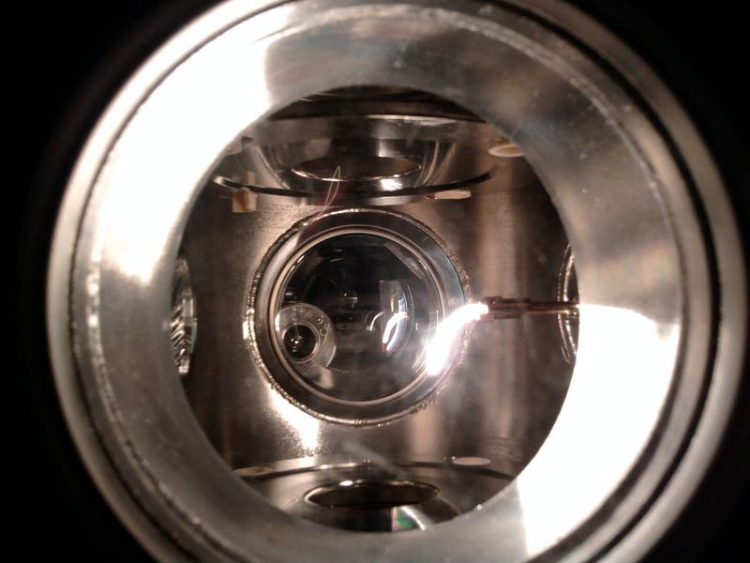Probing nobelium with laser light

Inner part of the gas-filled optical cell for laser spectroscopy of nobelium isotopes. M. Laatiaoui, GSI
Nuclei of heavy elements can be produced at minute quantities of a few atoms per second in fusion reactions using powerful particle accelerators. The obtained results are well described by nuclear models, which suggest the nuclei to have a bubble-like structure with lower density in their center than at their surface. The results were published in a recent article in Physical Review Letters.
Atoms consist of a positively charged nucleus surrounded by an electron shell. The inner electrons penetrate the volume of the nucleus and thus atomic level energies are influenced by the size and shape of the atomic nucleus. A difference in size of two different atomic nuclei resulting, for example, from a different number of neutrons results in a small shift of electronic energy levels.
Precise measurements of these energies are possible using laser light. Energy shifts are traced by varying the frequency and correspondingly the color of the light required to excite electrons to higher energy levels. So far, this method could only be applied to isotopes of lighter elements which are produced at larger production rates and whose atomic structure was already known from experiments with abundant long-lived or stable isotopes.
Nuclei of elements above fermium (Fm, Z=100) can be produced at minute quantities of a few atoms per second in fusion reactions and generally exist only for at most a few seconds. Therefore, their atomic structure was so far not accessible with laser spectroscopic methods.
In the current experiments, nobelium isotopes were produced by fusion of calcium ions with lead at the velocity filter SHIP at GSI’s accelerator facility. To enable laser spectroscopy, the high energetic nobelium atoms were stopped in argon gas. The results are based on a preceding experiment also conducted at GSI, exploring the atomic transitions of nobelium (No). The chemical element with atomic number 102 was discovered about 60 years ago.
The recent experiment investigated the isotopes No-254, No-253 and No-252 which differ in the number of constituent neutrons in their nuclei, with laser spectroscopy. The rates available for the experiment reached values below one ion per second for the isotope No-252.
From the measurements of the excitation frequency for the individual isotopes, the shift in color of the required laser light was determined for No-252 and No-254. For No-253, the fragmentation of the line into several hyperfine components induced by the single unpaired odd neutron was also resolved. The sizes and the shapes of the atomic nuclei were deduced from using theoretical calculations of the atomic structure of nobelium, which were carried out in collaboration with scientists from the Helmholtz Institute Jena in Germany, the University of Groningen in the Netherlands, and the University of New South Wales in Sydney, Australia.
The results confirm that the nobelium isotopes are not spherical but are deformed like an American football. The measured change in size is consistent with nuclear model calculations performed by scientists from GSI and from the Michigan State University in the USA. These calculations predict that the studied nuclei feature a lower charge density in their center than at their surface.
Thanks to these pioneering studies, further heavy nuclides will be accessible for laser spectroscopic techniques, enabling a systematic investigation of changes in size and shape in the region of heavy nuclei. These experiments are so far only possible at GSI and allow for a unique in-depth understanding of the atomic and nuclear structure of the heaviest elements. The results also play a role for the future facility FAIR (Facility for Antiproton and Ion Research), which is currently under construction at GSI. The same techniques and methods could also be employed in the low-energy branch of FAIR’s super fragment separator.
The experiments were conducted by an international team of scientists from GSI Helmholtzzentrum für Schwerionenforschung, Johannes Gutenberg-University Mainz, Helmholtz institute Mainz, TU Darmstadt, KU Leuven (Belgium), University of Liverpool (UK) und TRIUMF (Vancouver, Canada).
https://www.gsi.de/en/start/news/details/2018/06/27/probing_nobelium_with_laser_…
https://doi.org/10.1103/PhysRevLett.120.232503
Media Contact
All latest news from the category: Physics and Astronomy
This area deals with the fundamental laws and building blocks of nature and how they interact, the properties and the behavior of matter, and research into space and time and their structures.
innovations-report provides in-depth reports and articles on subjects such as astrophysics, laser technologies, nuclear, quantum, particle and solid-state physics, nanotechnologies, planetary research and findings (Mars, Venus) and developments related to the Hubble Telescope.
Newest articles

High-energy-density aqueous battery based on halogen multi-electron transfer
Traditional non-aqueous lithium-ion batteries have a high energy density, but their safety is compromised due to the flammable organic electrolytes they utilize. Aqueous batteries use water as the solvent for…

First-ever combined heart pump and pig kidney transplant
…gives new hope to patient with terminal illness. Surgeons at NYU Langone Health performed the first-ever combined mechanical heart pump and gene-edited pig kidney transplant surgery in a 54-year-old woman…

Biophysics: Testing how well biomarkers work
LMU researchers have developed a method to determine how reliably target proteins can be labeled using super-resolution fluorescence microscopy. Modern microscopy techniques make it possible to examine the inner workings…





















